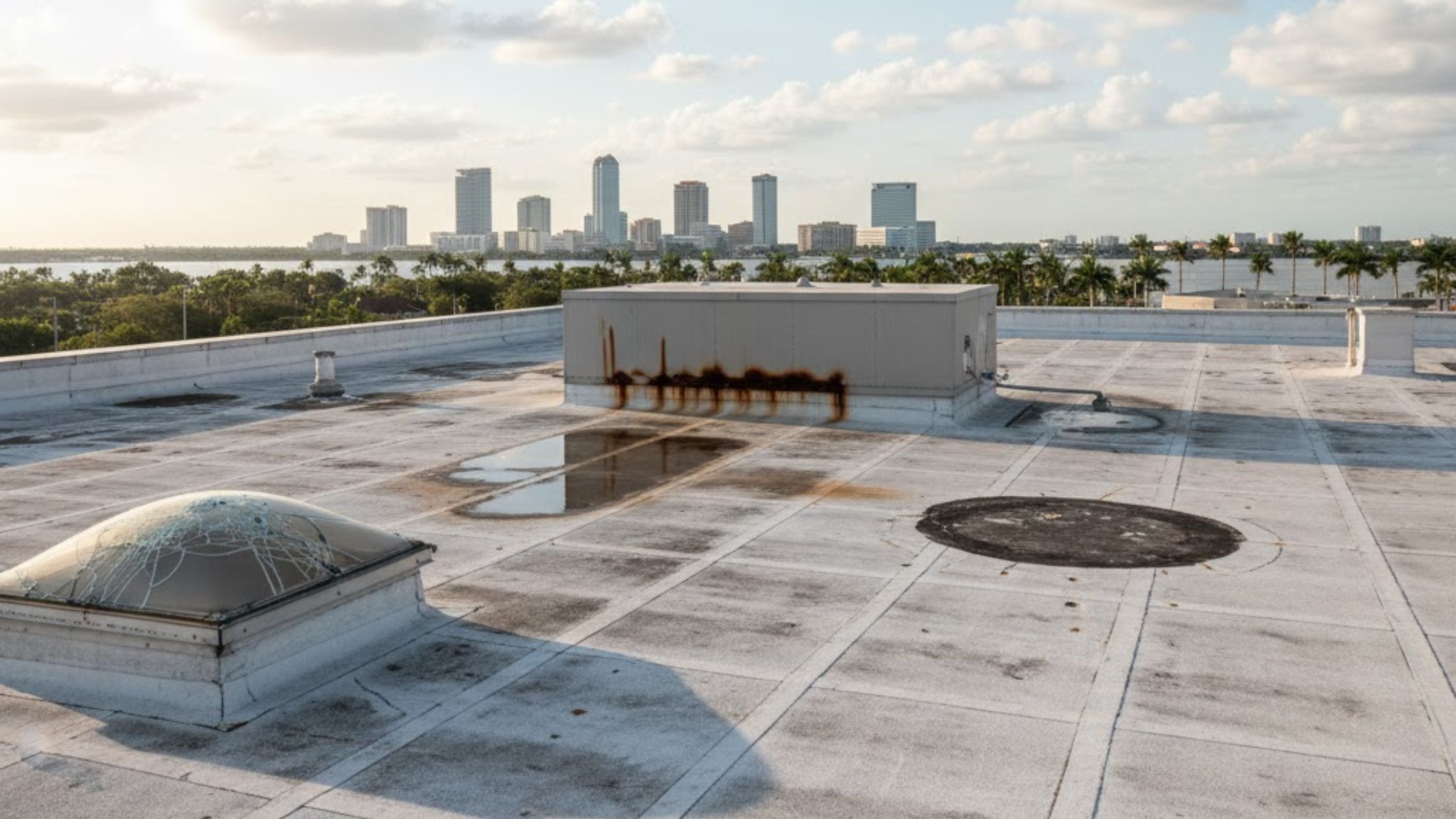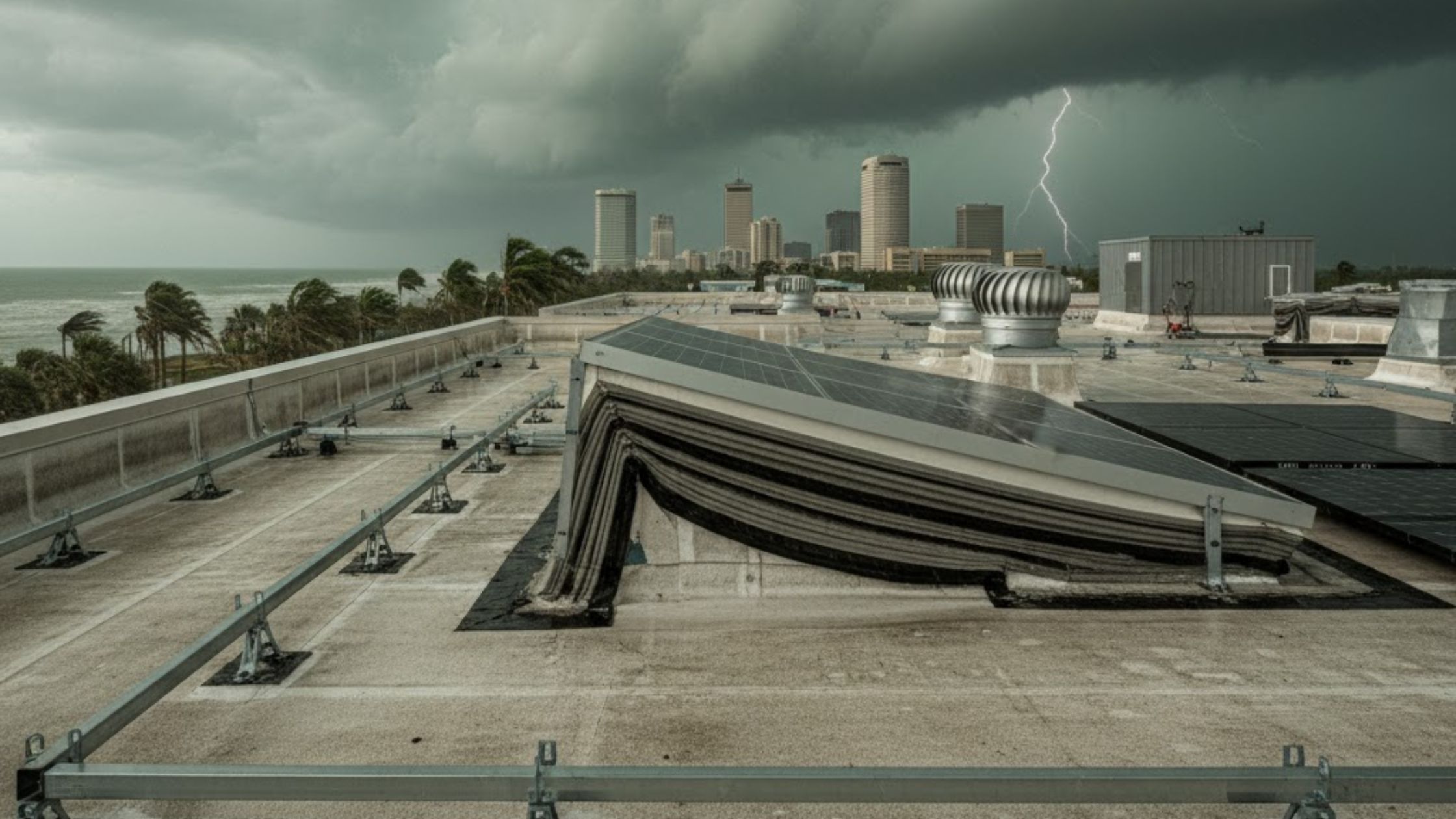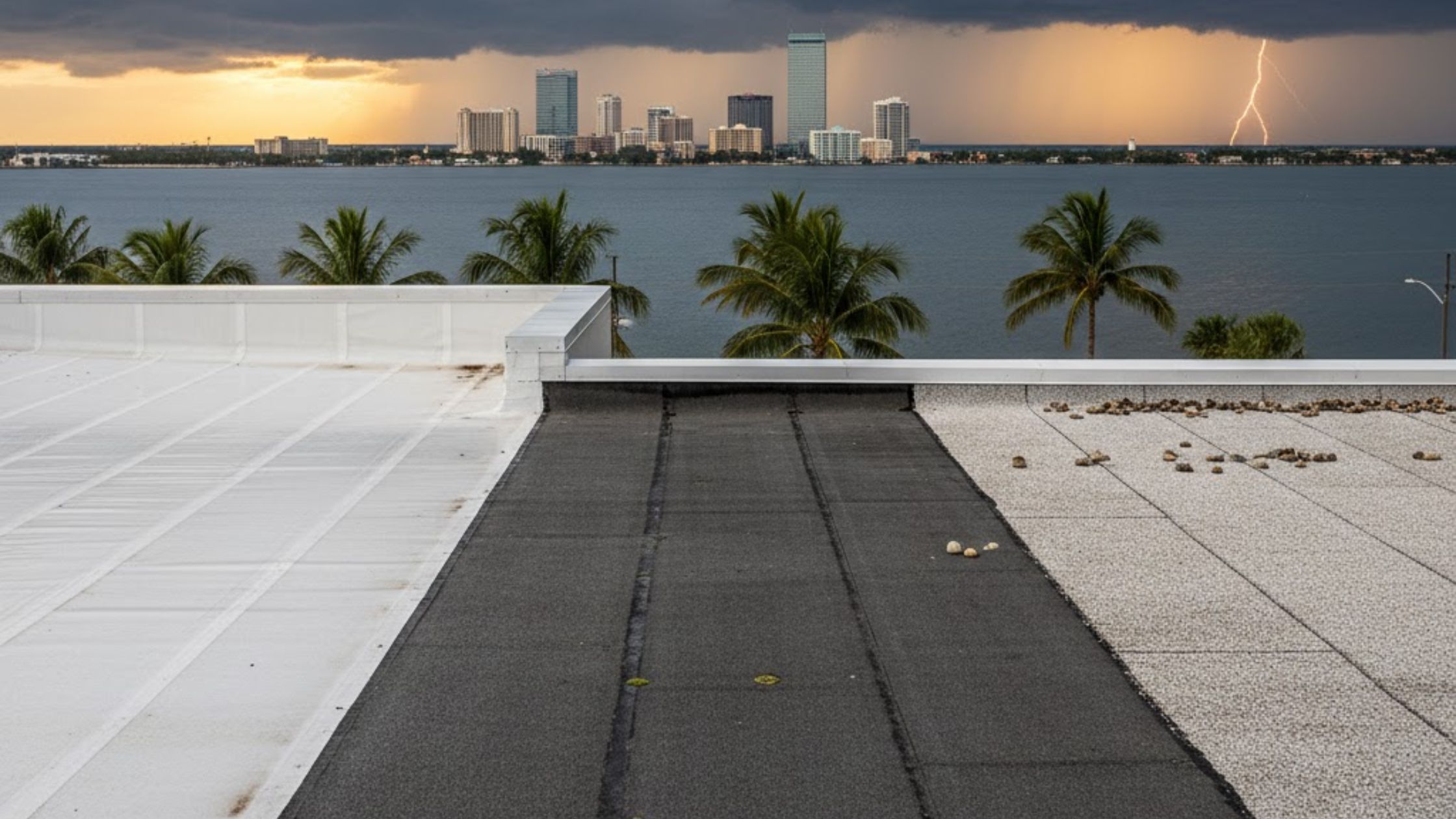What Are the Signs You Need a Full Shingle Roof Replacement Instead of a Simple Repair in Tampa?
Discover key signs that your Tampa roof needs full replacement, not just repair. Learn how to spot major damage & avoid costly roofing issues—get expert tips!

The roof over your head is more than just a protective layer; it is the single most important system safeguarding your entire Tampa home against the unique and often harsh elements of the Florida Gulf Coast. When trouble arises, the immediate question every homeowner faces is whether a simple repair will solve the issue, or if the time has come for a complete Shingle Roof Replacement Tampa. Making the wrong call can lead to wasted money, repeated damage, and ultimately, costly structural problems that far outweigh the investment of a new installation. This comprehensive guide details the precise indicators—from subtle material breakdown to obvious structural distress—that signal the absolute necessity of replacing your aging or damaged roofing system entirely to secure your peace of mind and property value.
What is the typical lifespan of a shingle roof in the challenging Florida climate?
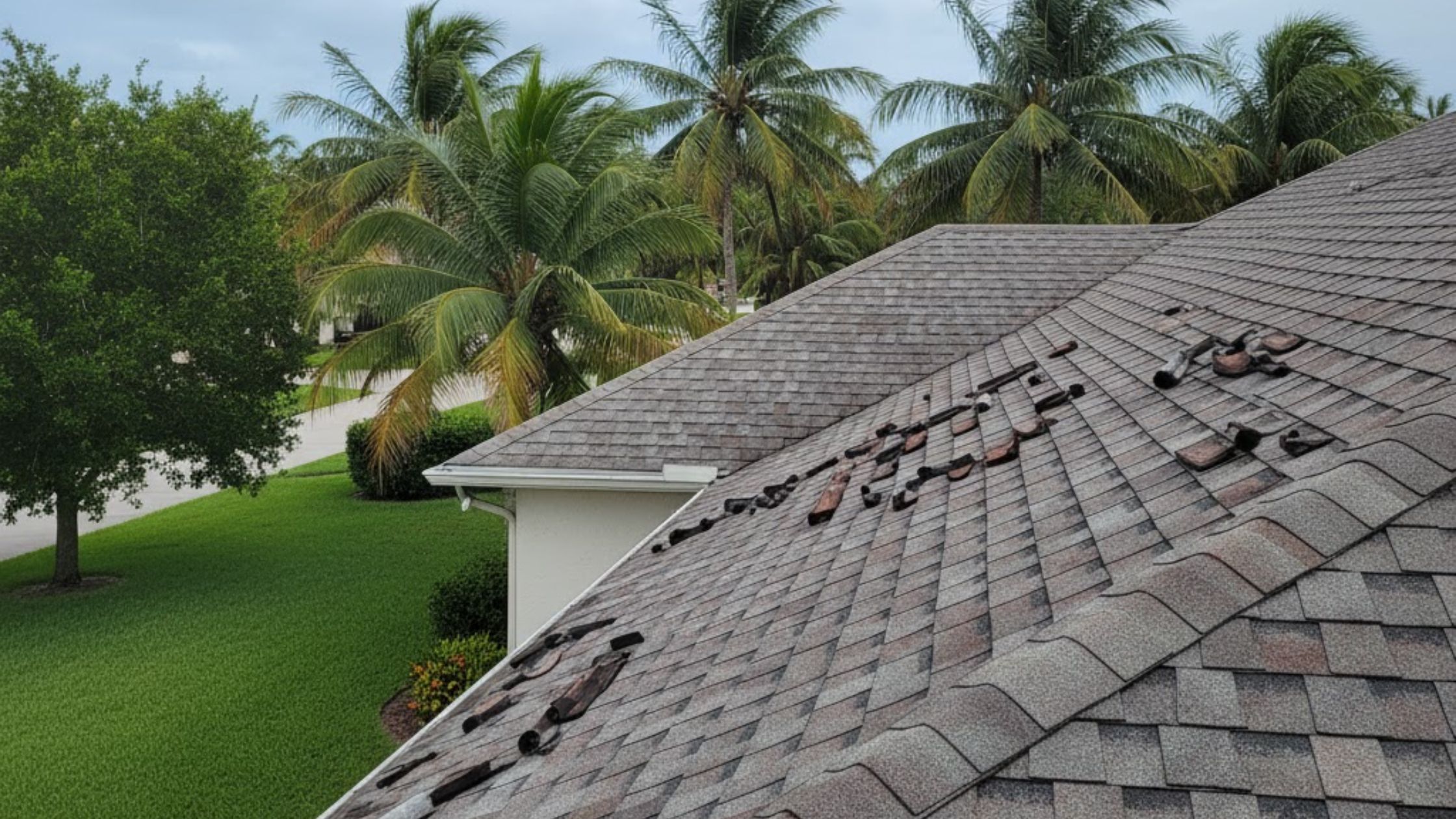
Understanding the expected service life of your roofing system is the foundational first step in deciding between a quick patch and a full overhaul. While asphalt shingles are a durable, widely used material across the nation, their longevity is significantly tested by the relentless sun, heat, and humidity present throughout the Tampa region. Florida’s climate can reduce the functional lifespan compared to cooler, milder geographical areas.
The degradation of the material is not just a matter of time passing; it is the direct result of continuous exposure to intense UV radiation and high ambient temperatures. This constant thermal cycling causes the asphalt material to expand and contract repeatedly, accelerating the internal breakdown of the shingles. Even premium materials often cannot reach their full manufacturer-rated lifespan when subjected to these daily environmental stresses.
For traditional three-tab shingles, the expected lifespan in Florida is often closer to 10 to 15 years, while more robust architectural shingles generally last between 15 and 25 years. If your roof is approaching or has exceeded the lower end of these ranges, any repair efforts may only provide temporary relief, making a comprehensive replacement the financially smarter decision.
Understanding 3-Tab vs. Architectural Shingles
The type of shingle currently installed on your home dictates much of its anticipated durability and performance. It is important to know which style you have, as this directly influences the timeline for necessary replacement.
- Three-Tab Shingles: These are characterized by their single, flat layer and uniform appearance, offering the most economical choice. Their lighter weight and simpler construction mean they are the most susceptible to Florida’s strong wind uplift and rapid degradation from the sun’s rays.
- Architectural Shingles (Laminated/Dimensional): These are constructed with multiple layers laminated together, creating a much thicker, heavier, and three-dimensional appearance. This layered construction provides superior resistance to wind, hail, and thermal shock, offering a significantly longer and more resilient service life in high-intensity weather zones.
Architectural shingles also feature better fire ratings and often contain specialized granules that improve solar reflectivity, which is a major benefit in the intense heat of the Florida summer. Identifying these differences is key during a professional inspection, as it helps determine the remaining useful life of the existing material. Choosing architectural shingles for your new installation is a smart long-term investment for resilience in the Tampa area.
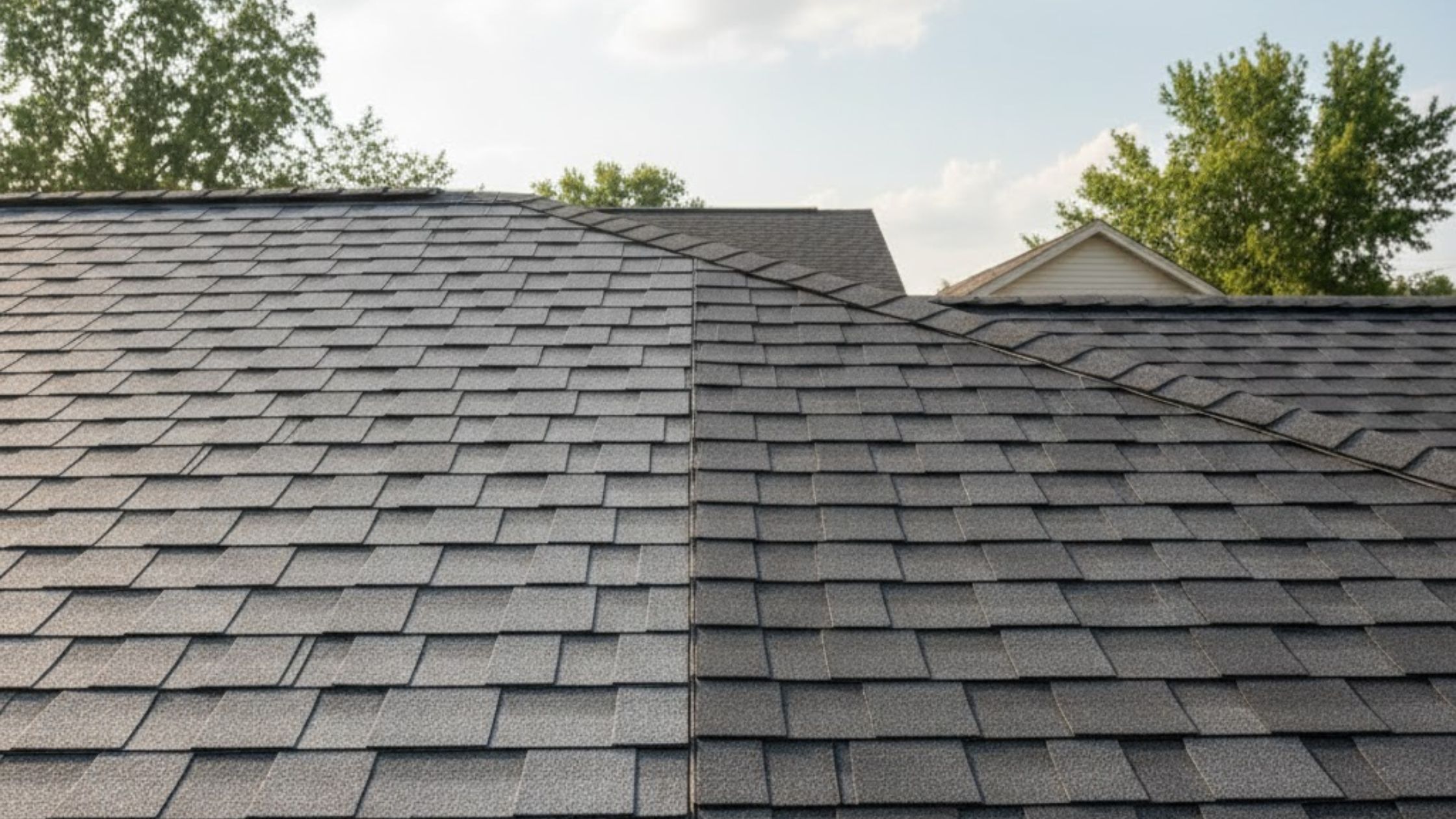
The Role of Climate in Longevity (Heat, Humidity, UV)
Florida’s climate creates a perfect storm for premature roofing wear, targeting the vulnerable components of asphalt shingles. The combination of intense solar radiation, high humidity levels, and frequent severe weather systems is relentless.
The UV radiation breaks down the asphalt binder that holds the protective surface granules in place, initiating the aging process. As the granules are lost, the asphalt layer itself becomes directly exposed to the sun, leading to faster deterioration and brittleness.
The high humidity environment also fosters the growth of biological entities such as algae and mold, which create dark streaks that absorb more heat and trap moisture. This accelerated aging from thermal and biological attack means that even shingles that look superficially intact may have lost their essential protective capabilities long before their maximum advertised lifespan. A full replacement allows you to upgrade to modern materials specifically designed to combat these local environmental threats.
When Does Widespread Shingle Wear and Tear Demand a Complete System Overhaul?

Visible deterioration of the shingle surface is perhaps the most obvious clue that your roof is nearing the end of its useful life. It is crucial to differentiate between isolated damage that can be fixed with a few replacement shingles and extensive, widespread wear that signals a total failure of the roofing material across the entire deck. This systemic breakdown indicates that the integrity of the whole system has been compromised, demanding more than a simple patch. The critical factors pointing to an unavoidable full replacement stem from persistent shingle wear and tear FL, which leaves the protective underlayers exposed.
Granule Loss: The Loss of Defense
Asphalt shingles are covered in small, ceramic granules that serve multiple essential functions, including protecting the asphalt layer from UV light and giving the roof its color and fire resistance rating. When these granules begin to shed, it is an unmistakable sign that the shingles are losing their protective effectiveness.
You might notice these tiny, sand-like particles accumulating in your gutters, at the base of your downspouts, or in the yard after heavy rains. If the granule loss is localized to one small area, it might be repairable, but if the loss is uniform and extensive across all roof planes, it signifies widespread aging. This extensive granule loss creates "bald spots" where the black asphalt is directly exposed, leading to rapid heating and deterioration of the structural matting underneath.
Curling, Cupping, and Buckling Shingles
The physical distortion of the shingle plane is another major indicator of failure. There are three primary ways this distortion manifests, and each points to significant problems:
- Cupping: Occurs when the shingle edges turn upward, usually due to moisture absorption or poor ventilation in the attic that causes uneven heating.
- Curling: Occurs when the shingle corners or edges begin to lift and curl backward, allowing rain and wind to penetrate beneath the shingle layer easily.
- Buckling: Appears as ripples or waves running up and down the roof slope, often caused by improperly installed underlayment, sheathing movement, or moisture trapped underneath the shingles.
When curling or buckling is observed across large sections of the roof, it demonstrates that the material's internal composition has failed and the entire roof membrane is compromised. At this point, attempting to flatten or spot-repair these areas is often futile and does not address the underlying material failure.
Visible Cracks and Fractures
Cracks are clear pathways for water infiltration and can rapidly lead to decking rot and interior leaks. While a shingle may develop a random small crack due to a localized impact, widespread cracking suggests that the shingles have become brittle and are failing due to age and temperature fluctuations.
Cracks most commonly occur near the fastener points or along the tabs of older three-tab shingles. If you see numerous shingles exhibiting long, visible fractures, the entire field of the roof has reached a point of no return. The extensive deterioration means the existing structure can no longer provide reliable water resistance. When considering the path forward, a full Shingle Roof Replacement Tampa is typically the most prudent action.
CB Roofing Solutions understands that deciding between a minor fix and a full investment can feel overwhelming. We specialize in providing detailed assessments that clarify the remaining life of your current materials, offering transparent recommendations for your home. We use modern, climate-appropriate shingles designed to give you maximum protection against the intense sun and storms common to our region. This ensures your home is secure for decades to come, far beyond what aging materials can offer.
How Can I Determine if Interior Water Damage Requires More Than a Patch?
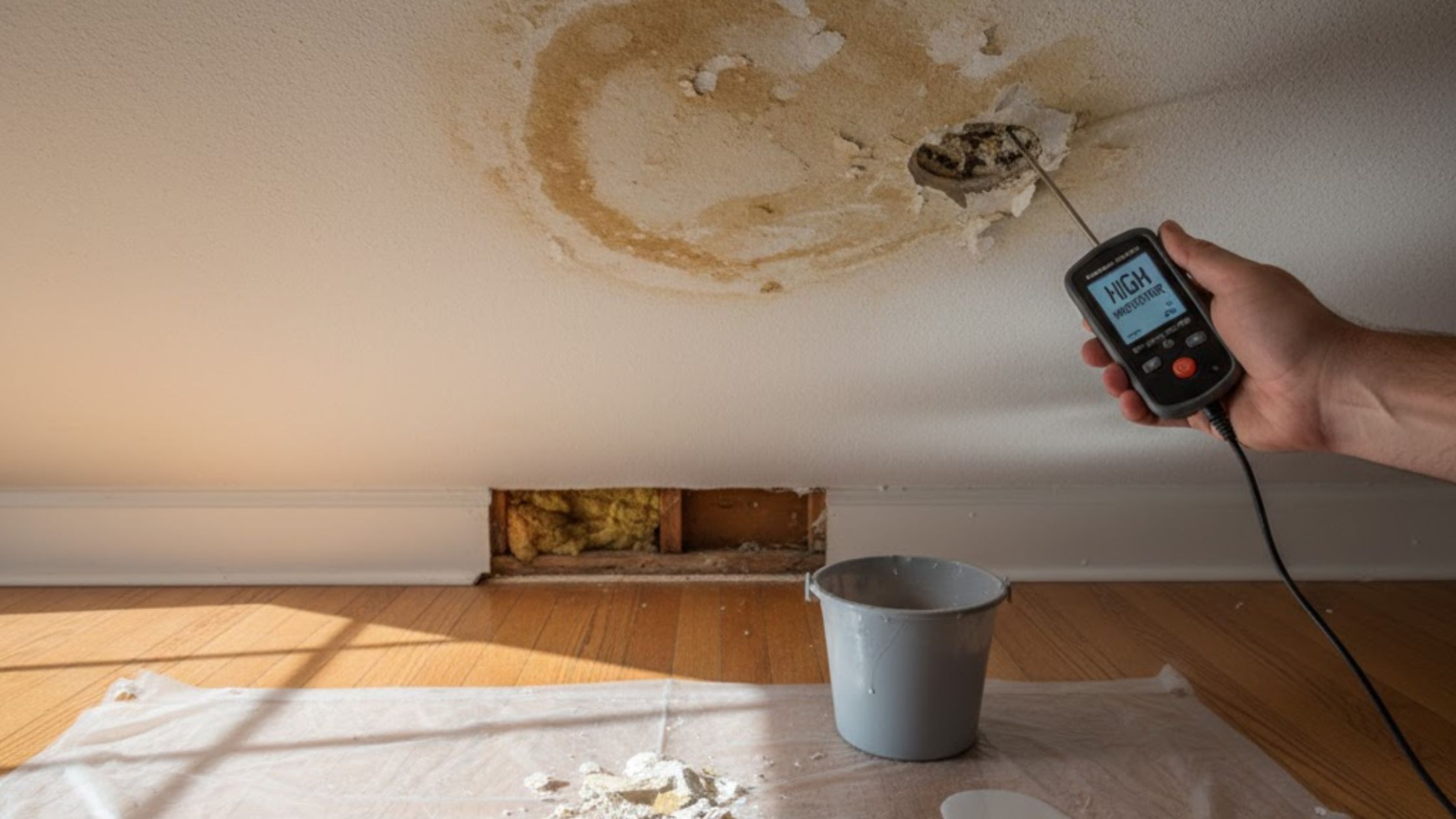
Water damage is the most critical sign of roof failure, as it directly impacts the structural integrity and interior air quality of your home. It’s essential to realize that a single leak is not always an isolated problem; it can be the first symptom of a broader, underlying systemic failure. By tracing the source of the water infiltration, you can determine if the damage is confined to one area or if it points toward the need for a total renewal of the roofing system.
The Danger of Multiple or Recurring Leaks
If you find yourself calling for roof repair after every major thunderstorm, or if leaks appear in different locations over a short period, this is a strong indicator that the roof membrane itself has failed. Isolated leaks can often be traced to damaged flashing around vents or chimneys, which are specific repairable points of entry. However, leaks scattered across the main roof plane suggest that the entire field of shingles and the underlying water barrier are no longer functioning correctly.
Recurring leaks waste money on temporary fixes that fail to address the core problem of an aging, compromised system. Patchwork repairs simply shift the water intrusion problem to the next weakest point of the aged roof structure. When leaks become chronic, the only way to achieve reliable, lasting protection is through a full replacement of the entire system.
Water Stains on Ceilings and Walls
While a leak in the attic is a direct sign of roof failure, water damage often presents itself as visual evidence in the living spaces of your home. Yellow or brown water stains on interior ceilings or running down walls are classic signs of persistent moisture intrusion. These stains often appear long after the actual leak has begun, meaning water has been pooling or slowly dripping for some time.
The location of the stain can sometimes be far from the actual entry point on the roof, as water travels along rafters and beams before finally dripping through the sheetrock. The presence of these stains is not just an aesthetic issue; it means the home's insulation has likely been saturated and its effectiveness drastically reduced. This widespread insulation damage contributes to higher energy costs and mold risk. If you are concerned about the investment required, you can research the average Tampa Shingle Roof Replacement Cost to get a clear financial picture before moving forward.
Inspecting the Attic and Sheathing for Rot
A thorough inspection of the attic space is indispensable when assessing the true extent of water damage. This area offers a crucial, unfiltered view of the roof’s underside. Homeowners should look for the following critical signs:
- Daylight: If you can see sunlight streaming into the attic through the roof decking, the breach is severe, and the shingle layer is completely compromised.
- Rotting Wood: Soft, spongy spots on the wooden roof decking (sheathing) or rafters, often accompanied by a musty odor, indicate wood rot. This rot is a structural issue and cannot be fixed with shingle repair alone.
- Mold and Mildew: Any visible mold or mildew growth on the rafters, sheathing, or insulation points to chronic moisture issues. Mold remediation is complex and often requires removal of all affected structural wood.
When the structural wood is compromised, a simple shingle repair is impossible because the fasteners would have nothing solid to hold onto. A full roof replacement is required, which includes stripping the entire system back to the rafters to replace the damaged wood decking and install a secure, new sheathing layer.
The Critical Importance of Flashing and Ventilation Failure

While shingles cover the vast majority of the roof plane, specialized components known as flashing and adequate ventilation are absolutely essential to the system's performance. Failure in these specific areas can sometimes be repaired, but when the breakdown is widespread or the underlying system design is flawed, a full replacement is the only reliable solution. These elements protect the most vulnerable areas of the roof and manage temperature.
Corrosion and Gaps Around Chimneys and Vents
Flashing is the thin metal material installed around penetrations—like chimneys, vent pipes, valleys, and skylights—designed to divert water away from these sensitive areas. Because flashing is often exposed metal, it can be susceptible to corrosion and failure over time, particularly in Florida's humid, salty environment.
When flashing fails, water can pour directly into the roof structure at the weakest points. Signs of flashing failure include:
- Rust or deterioration on metal surfaces.
- Gaps where the sealant has cracked or pulled away from the chimney or wall surfaces.
- Missing or damaged counter-flashing, which overlaps the base layer.
If an inspection reveals that multiple flashing points across the roof are severely degraded, it indicates a systemic failure that justifies a complete roof renewal. This approach ensures all new flashing is installed correctly and sealed properly with the new underlayment and shingles.
Poor Attic Airflow and Its Impact on Shingle Health
Ventilation is an often-overlooked factor that dramatically affects shingle longevity. An improperly ventilated attic traps a huge volume of hot, moist air generated by the Florida sun and the interior of the home. Temperatures in a poorly ventilated attic can easily exceed 150 degrees Fahrenheit.
This intense heat damages the shingles from the inside out, essentially baking the asphalt and accelerating granule loss and cracking. The trapped moisture also encourages wood rot and mold growth. Signs of ventilation issues can include:
- Premature curling or cupping of shingles, especially near the ridge.
- Excessive heat buildup inside the attic space.
- Higher-than-expected cooling costs during summer.
While sometimes ventilation can be improved by installing new ridge vents or soffit vents, often the replacement of an old roof system provides the ideal opportunity to fully redesign and optimize the ventilation system, ensuring the new shingles can achieve their maximum lifespan. This comprehensive approach prevents future heat-related failures.
What Severe Structural Issues Signal an Immediate Need for New Installation?
Structural issues are non-negotiable red flags that always point toward the necessity of a full replacement. These problems are often caused by long-term moisture intrusion, which has led to decay in the foundational wood components of the roof frame. When the structure itself is compromised, no amount of shingle repair can make the roof safe or secure. Addressing structural failure is a major project that requires immediate attention and expertise.
Sagging, Drooping, and Uneven Roof Planes
A roof structure should be perfectly straight and level from the ridge to the eaves. Any visible dip, sag, or unevenness in the roofline is a clear sign of structural compromise, likely due to a failing roof deck or damaged rafters. This severe issue is often caused by long-term, undetected water damage, excessive weight accumulation (such as pooled water or debris), or improper construction in the past.
A sagging roof cannot reliably support the weight of the shingles, the underlayment, or the stresses applied by high winds. Trying to simply repair the surface of a sagging roof is a dangerous, temporary measure that ignores the underlying failure. This requires immediate stripping of the entire system to allow for the replacement of damaged sheathing and reinforcement or replacement of the structural supports. The need for specialized work on the substructure is paramount when this evidence is present.
Damaged Decking or Underlying Framework
The roof decking, or sheathing, is the layer of plywood or oriented strand board (OSB) directly beneath the underlayment and shingles. It provides the crucial nailing surface and structural stability. Prolonged leaks cause this decking to soften, swell, and eventually rot.
During a professional inspection, the roofing expert will walk the roof and check for soft or spongy areas underfoot, which indicate weak spots in the decking. These areas are incapable of securely holding a shingle fastener, meaning that even brand-new shingles would be easily pulled off by high winds. When the decking is visibly rotten or soft in numerous places, a full replacement, including the necessary wood replacement, becomes mandatory. This level of comprehensive service is what you can expect from Reliable Roofing Services Near Tampa.
Recognizing the severity of structural failure is vital for the safety and longevity of your Tampa home. We perform thorough internal and external inspections to accurately diagnose these structural deficiencies, ensuring that when we install a new system, it is built upon a sound, sturdy foundation. We focus on durability that lasts for decades, not just quick fixes.
How Do Severe Weather Events Impact the Decision to Repair or Fully Replace?
Tampa's coastal location means severe weather, particularly during hurricane season, is an annual reality that must be factored into all roofing decisions. While standard damage like a few lost shingles can be addressed with simple repairs, the impact of significant storm events can accelerate the aging of an already worn roof to the point where replacement is the only logical and safe choice. Storms don't just cause visible damage; they expose and exploit every existing vulnerability.
Wind Damage and Missing Shingles
High winds, common in Florida thunderstorms and hurricanes, test the integrity of every shingle seal. If only a few shingles are missing after a storm, and the rest of the roof is relatively new and in good condition, a spot repair is often adequate. However, if a storm causes the loss of shingles in multiple, scattered areas across the roof, or if the loss occurs on an older roof nearing the end of its life, it signals systemic failure.
When the adhesive sealant of the shingles is weak due to heat aging and granule loss, even moderate winds can peel them back, exposing the underlying underlayment and decking. If the wind uplift damage is widespread, replacement guarantees that you receive a new roofing system with fresh seals, properly rated for wind resistance, giving you better protection for future seasons.
Hail Impact and Accelerated Deterioration
While Tampa does not experience the severe hailstorms common in other regions, hail damage is still possible and can be insidious. Even small hail can cause two main types of damage to asphalt shingles:
- Granule Displacement: Hail strikes knock off protective granules, creating circular "bruises" or dark spots. These areas are then exposed to UV rays, leading to rapid deterioration.
- Mat Fracture: A hard hail impact can fracture the fiberglass matting beneath the granules without immediately puncturing the shingle. This internal fracture compromises the shingle's water resistance and makes it brittle and prone to cracking over time.
If an inspection finds widespread hail damage, especially on an older roof, a full replacement is recommended. The combined effect of hail damage and existing aging drastically reduces the remaining useful life, making any spot repair a short-term, high-risk proposition. The decision to invest in a new roof is the most effective way to mitigate the Hurricane Impact on Shingle Roofs that Florida homeowners must constantly consider. Our professional assessments will accurately determine the total extent of storm damage, ensuring all necessary steps are taken.
CB Roofing Solutions is committed to helping you weather any storm. We understand the unique demands of the Gulf Coast environment, and our replacement installations are designed to meet or exceed the highest wind-mitigation and water-intrusion standards required in the state.
The Practical Economics: Comparing the Cost of Perpetual Repairs vs. New Roofing
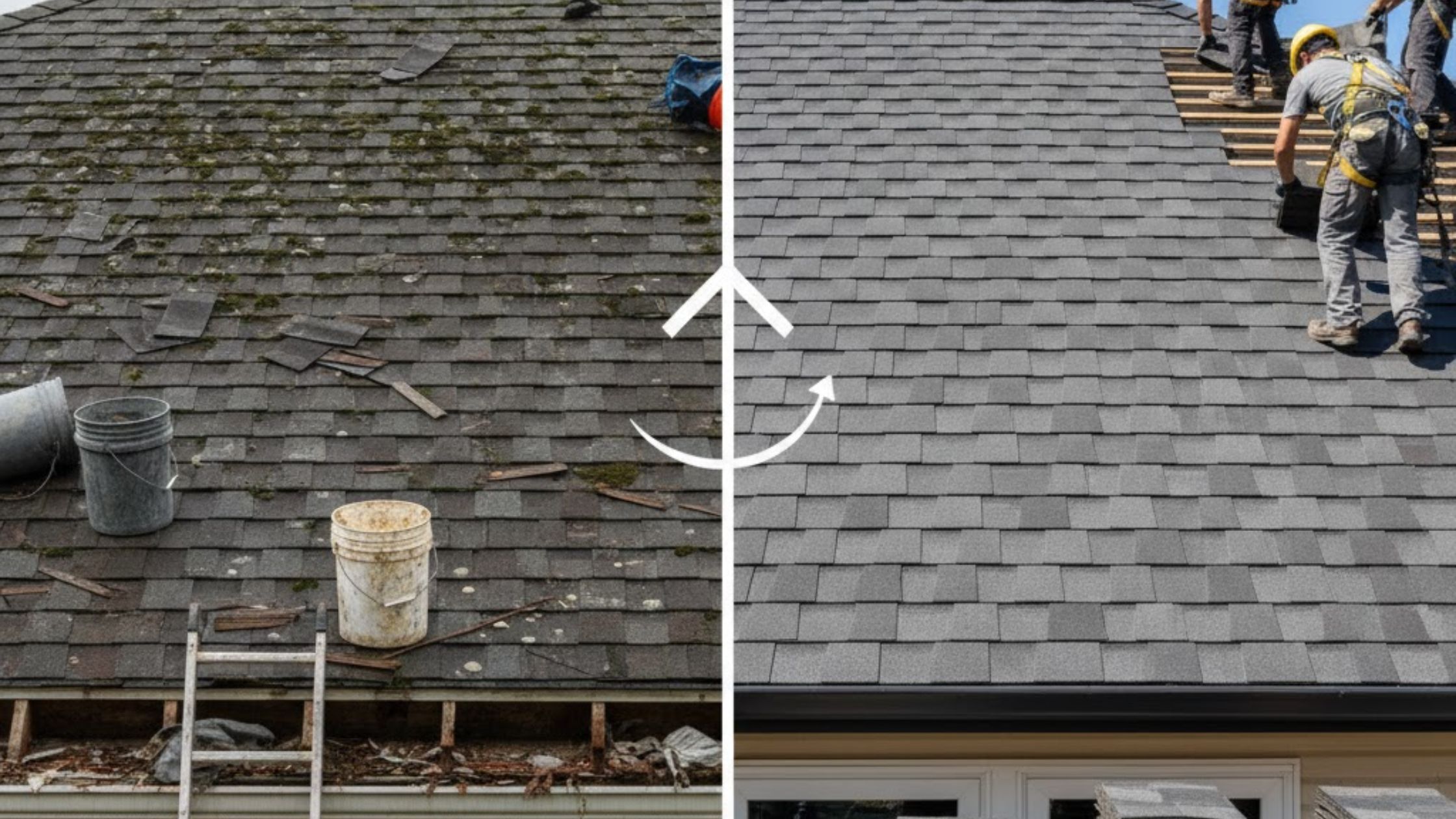
A vital part of the repair-versus-replace decision is a clear-eyed look at the finances. It may seem cheaper to opt for a small repair today, but when that repair is followed by another, and then another, the accumulated costs quickly exceed the sensible threshold for investing in a complete new system. This cost-benefit analysis must factor in not only immediate expenses but also future liabilities, energy efficiency, and insurance implications.
The 25-30% Replacement Threshold
A common industry standard used by financial and roofing experts is the 25-30% replacement threshold. This metric suggests that if the cost of the necessary repairs or the cumulative cost of repeated repairs over a short period (say, two to three years) reaches 25% to 30% of the cost of a full roof replacement, then replacement is the more economical decision.
This calculation is based on the idea that spending a quarter or more of the cost of a new roof on temporary patches is poor financial planning. A new installation provides a full, long-term warranty, enhanced structural protection, and improved energy efficiency, none of which are offered by minor repairs to an aging system. Considering this financial benchmark helps homeowners make a practical decision based on long-term value. Having a clear plan is essential, and our team can provide guidance on the Tampa Roof Replacement Timeline to help you budget accordingly.
Insurance Considerations for Aged Roofing Systems
In the Florida insurance market, the age of your roof is a major factor in determining both insurability and premium costs. Many insurance carriers have strict guidelines, often refusing to renew policies on homes with roofs exceeding 15 to 20 years in age, or requiring a full replacement before issuing a new policy.
Even if an older roof is technically repairable after a storm, the insurance company may only cover the depreciated, actual cash value of the damage, leaving the homeowner to cover a significant portion of the cost. A new roof, however, often qualifies for wind-mitigation credits and reduced premiums because it meets current building codes and standards. Investing in a new roofing system ensures your home remains insurable and protected by comprehensive coverage.
What is the Process for a Professional Roof Damage Inspection in Tampa?
Before any major roofing decision is made, a thorough, professional inspection is non-negotiable. This process, known as a roof damage inspection Tampa, goes far beyond a casual glance from the ground. It involves a systematic, multi-point evaluation conducted by certified experts who understand the subtle signs of material failure and structural weakness specific to Florida homes. This detailed assessment provides the objective data required to make an informed choice between repair and replacement.
Initial Visual Assessment
The first stage of the inspection involves a meticulous visual check of all roof planes and ground-level signs of distress. The inspector documents all obvious issues:
- Missing, cracked, or severely curled shingles.
- Accumulations of granules in the gutters and at the base of downspouts.
- Visible dark streaks, moss, or large areas of discoloration on the roof surface.
- Distorted or sagging roof ridges and eaves.
This initial assessment provides a broad overview of the roof's general health and sets the stage for the more detailed component-by-component investigation that follows.
Comprehensive Inspection Areas
The detailed phase of the inspection focuses on all the critical penetration points and internal systems. Inspectors use specialized knowledge to look for subtle cues that often indicate hidden damage:
- Flashing: Checking for corrosion, open seams, or failed sealant around chimneys, vents, and roof-to-wall transitions.
- Attic Examination: Inspecting the underside of the decking, rafters, and insulation for water stains, mold, rot, and proper ventilation flow.
- Decking Integrity: Physically checking for spongy or soft spots in the plywood or OSB, confirming that the structural nailing base is sound.
- Siding and Eaves: Examining the fascia and soffit areas for signs of drip edge failure or water backup that has damaged the surrounding perimeter of the home.
A comprehensive roof damage inspection Tampa ensures that no hidden issue, no matter how small, is overlooked, giving you a complete, authentic picture of your roof's condition. This level of diligence saves homeowners from costly surprises later.
Receiving the Detailed Assessment Report
Following the on-site inspection, a professional roofing company provides a detailed, written report that clearly outlines the findings. This report should classify the damage found, clearly explaining what is localized and repairable versus what is widespread and necessitates replacement. The document includes photographs and explicit descriptions of the problems, which are invaluable when dealing with insurance claims. This report is your essential tool for understanding the full scope of work required to secure your Tampa property.
The Benefits of Investing in a Modern Roofing System
Opting for a full roof replacement is not just about stopping leaks; it is a profound investment that immediately delivers substantial, tangible benefits to your home. A new roofing system represents a significant upgrade in terms of protection, energy performance, and overall property value, making it a pivotal long-term decision for any Tampa homeowner. Modern materials and installation techniques offer advantages that simply cannot be replicated by patching an old roof.
Enhanced Energy Efficiency
One of the most immediate and appreciated benefits of a new roof installation in Florida is the substantial improvement in energy efficiency. Modern asphalt shingles, especially architectural and designer lines, are often treated with granules that possess higher solar reflectivity. These specialized pigments reflect more of the sun’s intense heat away from the roof surface.
When combined with a properly installed, continuous ventilation system, this enhanced reflectivity dramatically reduces the temperature of the attic space. A cooler attic means less heat transfer into the living areas of your home, allowing your air conditioning system to work less intensely. This translates directly to a noticeable reduction in monthly cooling bills, creating a passive return on your roofing investment year after year.
Improved Curb Appeal and Property Value
A new roof instantly transforms the aesthetic of any home. If you are preparing to sell your property or simply want to refresh its appearance, a brand-new roof provides maximum curb appeal. Modern shingles come in a wide array of colors, textures, and dimensions that mimic the high-end look of slate or wood shake.
Home buyers recognize a new roof as a major asset, knowing that they will not face a large replacement expense for decades. A full replacement is a verifiable increase in property value and is often cited by real estate agents as one of the best renovation investments with the highest return on investment. Furthermore, the fresh, clean look of new shingles greatly enhances the visual appeal of your entire neighborhood. CB Roofing Solutions takes pride in delivering stunning results that boost both the protection and the aesthetic of your home.
Manufacturer and Workmanship Warranties
A new roofing system comes with dual protection in the form of warranties, which is something a simple patch cannot provide.
- Manufacturer’s Warranty: This covers the shingles themselves against defects, often extending for 25 to 50 years, depending on the product line.
- Workmanship Warranty: This is provided by the installer and guarantees the quality of the labor and installation for a defined period, typically covering any issues arising from improper technique.
This comprehensive warranty package provides invaluable long-term security. Should any failure occur within the warranty period, the cost of repair or replacement is covered, safeguarding your investment for the future. This peace of mind is one of the most compelling reasons to choose replacement over continuous, risky repairs.
Frequently Asked Questions About Roof Replacement
When homeowners in the Tampa area are faced with the prospect of replacing their roof, they often have similar questions regarding the process, the costs, and the logistics. Having clear, concise answers helps demystify the process and allows for a smooth transition from assessment to installation. Here are answers to some of the most common inquiries we receive.
Does insurance cover an old roof replacement?
Insurance coverage for an aged roof replacement varies significantly based on your policy type and the cause of the damage. If the damage is sudden and accidental—such as from a named hurricane or severe storm—coverage is much more likely. However, for a roof failing purely due to age and lack of maintenance, the policy may not cover replacement, or it may only cover the depreciated value of the old roof, leaving the homeowner responsible for the majority of the cost. It is essential to consult with your insurance agent and get a professional damage report to understand your specific coverage before starting the process.
What is the 25-30% replacement threshold for roof repairs?
The 25-30% threshold is an industry guideline used to evaluate the economic feasibility of repairs. If the cost of repairing the roof—or the accumulated cost of repeated repairs—exceeds 25% to 30% of what a complete new roof would cost, replacement is typically the wiser long-term financial choice. Spending a substantial portion of the replacement cost on temporary fixes is rarely justified, as a new roof provides a full warranty and 20-30 years of secure, maintenance-free life.
How long does a shingle roof replacement typically take in Tampa?
The duration of a full shingle roof replacement project depends on the size and complexity of the roof, as well as the local weather conditions. In the Tampa area, most residential shingle roof replacements are completed within a remarkably efficient timeline of two to five days from start to finish. Larger or more complex roofs may take longer, especially if extensive structural wood repair is required. Professional contractors prioritize efficiency and proper execution, recognizing the importance of minimizing disruption to your daily life.
Can I install new shingles over existing ones?
While technically possible, installing new shingles directly over existing ones, known as a layover or re-roof, is strongly discouraged by nearly all roofing professionals in Florida. The practice may save a small amount of money initially but voids many manufacturer warranties and is often prohibited by local building codes for multiple layers. More importantly, it prevents the inspection of the underlying roof decking for critical rot, mold, or structural damage, which is essential for hurricane readiness. A full tear-off and replacement is the only method that ensures the new system is built on a sound, healthy foundation.
How often should I have my roof inspected in Florida?
Given the intense environmental stress caused by the Florida climate, it is highly recommended that homeowners schedule a professional roof inspection at least once every year. The ideal time for this preventative check-up is in the late spring, just before the official start of hurricane season on June 1st. Regular, proactive inspections help identify minor issues like cracked sealant, minor flashing damage, or small areas of granule loss before they escalate into major, expensive problems that necessitate a full replacement. This annual diligence is the best way to extend the service life of your roof.
Final Words
Ultimately, protecting your Tampa property requires vigilance and an understanding of the difference between an aged system and a repairable one. When the signs of widespread material fatigue, chronic leaks, or structural compromise are present, the responsible, long-term choice is always a full Shingle Roof Replacement Tampa. This investment secures the value, safety, and energy efficiency of your home for the next generation. If you notice any of the warning signs detailed in this guide, or if your roof is simply approaching the 20-year mark, the best course of action is to schedule a professional, obligation-free assessment with our trusted team. Take the first step toward guaranteed home security by choosing to contact us today.

